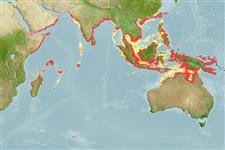Teleostei >
Clupeiformes (Herrings) >
Dorosomatidae (Gizzard shads and sardinellas)
Etymology: Hilsa: Bangladesh and Bengali local name for a fish.
More on author: Cuvier.
Environment: milieu / climate zone / depth range / distribution range
生态学
海洋; 淡水; 半咸淡水; 溯河洄游 (Ref. 51243); 深度上下限 10 - ? m (Ref. 30573). 熱帶; 25°N - 18°S, 43°E - 155°E (Ref. 54554)
Indo-West Pacific: probably all coasts of Indian Ocean, from Gulf of Oman and Gulf of Aden south to Durban and Madagascar, across the Bay of Bengal, Gulf of Thailand, Java Sea and north to Hong Kong and east to Papua New Guinea and possibly further (Ref. 188).
印度-西太平洋: 印度洋的可能所有海岸,從阿曼灣與亞丁灣南至南非的川斯凱與馬達加斯加, 越過孟加拉灣,泰國灣, 爪哇海而且北至香港而且東至巴布亞新幾內亞與可能更遠。
Length at first maturity / 大小 / 重量 / 年龄
Maturity: Lm 15.0 range ? - ? cm
Max length : 35.0 cm TL 雄鱼/尚未辨别雌雄; (Ref. 11228); common length : 16.5 cm SL 雄鱼/尚未辨别雌雄; (Ref. 188)
背棘 (总数) : 0; 背的软条 (总数) : 16 - 19; 臀棘: 0; 臀鳍软条: 17 - 23. Diagnosis: Body fairly deep and compressed, belly with distinct keel of scutes; top of head with numerous fronto-parietal striae; upper jaw with median notch; gillrakers about 100 to 175, those on inner arches distinctly curled; outer row of gill filaments on first arch not more than half length of gillrakers; a series of small triangular scales above axil of pectoral fin; hind part of body scales perforated (Ref. 188). A black spot behind gill cover, usually followed by up to 10 spots along flank (Ref. 188).
头顶有很多的额顶骨陷纹; 上颌有中央的凹槽。 鳃耙大约 100 到 175, 在内弓上的那些明显地卷曲; 在第一鳃弓上的鳃丝的外部列不超过鳃耙的一半长度。 在胸鳍的叶腋上面的一系列的小三角形的鳞片; 身体鳞片的后部部份穿孔的。 在鳃裂后面的一个黑色的斑点; 通常 10 沿着侧面。
Found in coastal waters (Ref. 3107, 30573); marine, pelagic, but entering estuaries and able to tolerate quite low salinities (7 ppt) (Ref. 188). Feeds chiefly on phytoplankton, mainly diatoms, also dinoflagellates, but also copepods, molluscan and crustacean larvae, prawns, amphipods and polychaetes (Ref. 188). Spawns, at least in Godavari estuary, around February (Ref. 188). Marketed fresh, dried, dried-salted and boiled. Made into fish balls.
发现于沿岸水域 (参考文献 30573), 进入河口而且能容忍相当低的盐度 (7个 ppt) 。 主要捕食浮游植物 (主要地硅藻 , 也吃腰鞭毛虫) ,也吃桡足类, molluscan 与甲壳类幼生,虾,片脚类动物与多毛类动物。 产卵 (至少在 Godavari 河口) 二月左右。 (参考文献 188) 在市场上销售生鲜地,乾制了, 乾燥盐腌与煮沸的。 制成了鱼丸。 发现于下面湄公河的整个流域主流了。 (参考文献 36667)
Life cycle and mating behavior
成熟度 | 繁殖 | 产卵场 | 卵 | 孕卵数 | 仔鱼
印度-西太平洋: 印度洋的可能所有海岸,從阿曼灣與亞丁灣南至南非的川斯凱與馬達加斯加, 越過孟加拉灣,泰國灣, 爪哇海而且北至香港而且東至巴布亞新幾內亞與可能更遠。
Whitehead, P.J.P., 1985. FAO Species Catalogue. Vol. 7. Clupeoid fishes of the world (suborder Clupeoidei). An annotated and illustrated catalogue of the herrings, sardines, pilchards, sprats, shads, anchovies and wolf-herrings. FAO Fish. Synop. 125(7/1):1-303. Rome: FAO. (Ref. 188)
世界自然保护联盟红皮书 (Ref. 130435: Version 2024-2)
人类利用
渔业: 高经济性; 诱饵: occasionally
工具
特别资料
下载 XML
网络资源
Estimates based on models
Preferred temperature (Ref.
123201): 25.8 - 29.1, mean 28.3 °C (based on 772 cells).
Phylogenetic diversity index (Ref.
82804): PD
50 = 1.0000 [Uniqueness, from 0.5 = low to 2.0 = high].
Bayesian length-weight: a=0.01023 (0.00643 - 0.01629), b=3.03 (2.90 - 3.16), in cm total length, based on LWR estimates for this species & (Sub)family-body (Ref.
93245).
营养阶层 (Ref.
69278): 2.9 ±0.33 se; based on food items.
Generation time: 1.0 ( na - na) years. Estimated as median ln(3)/K based on 1
growth studies.
回复力 (Ref.
120179): 高度, 族群倍增时间少于 15个月 (K=1.1).
Fishing Vulnerability (Ref.
59153): Low vulnerability (18 of 100).
Climate Vulnerability (Ref.
125649): High to very high vulnerability (71 of 100).
Nutrients (Ref.
124155): Calcium = 204 [116, 375] mg/100g; Iron = 2.01 [1.12, 3.29] mg/100g; Protein = 19.2 [18.1, 20.2] %; Omega3 = 0.411 [0.231, 0.728] g/100g; Selenium = 61.5 [30.1, 125.8] μg/100g; VitaminA = 9.95 [4.03, 23.19] μg/100g; Zinc = 1.78 [1.25, 2.60] mg/100g (wet weight);
